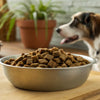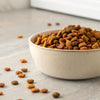How Much Dry Dog Food to Feed My Dog: A Comprehensive Guide
- Houndsy
Table of Contents
- Introduction
- Understanding Your Dog’s Nutritional Needs
- Calculating the Right Food Portion
- Types of Dog Food and Feeding Strategies
- Monitoring Your Dog’s Health and Weight
- Key Takeaways
Introduction
Did you know that approximately 59% of dogs in the United States are classified as overweight or obese? This staggering statistic underscores the importance of understanding how much dry dog food to feed our furry companions. As pet parents, we want to provide the best for our dogs, ensuring they maintain a healthy weight while getting the right nutrients to thrive. However, figuring out the precise amount of food can be confusing, especially when considering factors like age, size, activity level, and health status.
In this blog post, we will delve into the factors that influence a dog's dietary needs and provide actionable insights on how to determine the appropriate portion sizes for your pup. By the end of this comprehensive guide, you will have a clear understanding of how much dry dog food to feed your dog and the best practices to keep them healthy and happy.
We will cover the following topics:
- The fundamental factors affecting your dog's nutritional needs
- How to read and interpret dog food labels
- Recommended feeding guidelines based on different life stages
- The impact of activity levels and health conditions on food intake
- Practical tips for adjusting portions and monitoring your dog's weight
Let’s embark on this journey to better understand our canine friends' dietary needs, ensuring they get the perfect balance of nutrition and portion control!
Understanding Your Dog’s Nutritional Needs
Just like humans, dogs require a balanced diet to maintain their health. Their nutritional needs include macronutrients—proteins, fats, and carbohydrates—as well as essential micronutrients such as vitamins and minerals. Here’s a deeper look into what your dog needs:
1. Macronutrients
- Proteins: Essential for muscle growth, repair, and overall bodily functions. High-quality protein sources include meat, fish, and poultry.
- Fats: Provide energy and assist in the absorption of fat-soluble vitamins. Healthy fat sources include fish oil and chicken fat.
- Carbohydrates: Offer energy and support digestive health through fiber. Whole grains, fruits, and vegetables are excellent carbohydrate sources.
2. Micronutrients
- Vitamins and Minerals: Vital for various bodily functions, including immune system support and bone health. Look for dog foods that contain a blend of vitamins A, D, E, and B-complex vitamins.
3. Water
While not a nutrient per se, water is crucial for your dog’s overall health. Always ensure fresh water is available for your pup, especially when feeding dry kibble.
4. Life Stage Considerations
Dogs have different nutritional needs depending on their age:
- Puppies: Require more calories, protein, and fat for growth and development.
- Adults: Need a balanced diet that maintains their weight and health.
- Seniors: May benefit from lower-calorie diets with joint-supporting nutrients like glucosamine.
5. Breed and Size
Different breeds have varying nutritional requirements. For instance, large breeds might require diets that support joint health, while small breeds may need more calorie-dense diets due to their faster metabolism.
Understanding these fundamentals sets the stage for accurately determining how much dry dog food to feed your dog.
Calculating the Right Food Portion
Now that we’ve covered the basics of dog nutrition, let’s discuss how to calculate the appropriate portion sizes based on various factors.
1. Starting with the Feeding Guidelines
Most dog food brands provide feeding guidelines on the packaging, which are typically based on your dog's weight. These guidelines are a great starting point but should be adjusted based on your dog's individual needs.
For example, if your dog weighs 60 pounds, the feeding chart may suggest 3 to 4 cups of food per day. However, this is just a guideline.
2. Factors Influencing Portion Size
- Age: Puppies need more frequent meals (3-4 times a day) compared to adults (2 times daily). Senior dogs may require fewer calories but still need high-quality protein.
- Activity Level: Active dogs may need more food to sustain their energy, while less active dogs require fewer calories.
- Health Status: Dogs with certain health conditions may need specific diets. For instance, overweight dogs should be on a calorie-restricted diet, while underweight dogs may need a more calorie-dense food.
3. Monitoring Weight and Adjusting Portions
Regularly monitor your dog’s weight and body condition score (BCS). A BCS of 4-5 out of 9 is ideal, where your dog has a noticeable waist, and you can feel their ribs without excess fat. If your dog is gaining or losing weight, adjust their food intake accordingly.
4. Using a Feeding Calculator
Many pet food manufacturers provide online feeding calculators. You can input your dog’s weight, age, activity level, and health status to receive tailored feeding recommendations.
Types of Dog Food and Feeding Strategies
Choosing the right type of dog food is just as important as determining the amount. Here’s a look at different food types and feeding strategies:
1. Dry Dog Food (Kibble)
Dry dog food is the most common choice among pet owners. It’s convenient, cost-effective, and has a long shelf life. Plus, kibble can help keep your dog’s teeth clean due to its abrasive texture.
2. Wet Dog Food
Wet food can be more appealing to picky eaters and helps increase moisture intake. However, it’s often more expensive and has a shorter shelf life than dry food.
3. Raw Dog Food
Some pet owners opt for raw diets, which are believed to be more natural. These can be nutrient-dense but require careful handling and should be balanced to avoid deficiencies.
4. Feeding Strategies
- Free Feeding: Leaving food out all day for your dog to graze. This method works for some dogs but can lead to overeating.
- Scheduled Feeding: Providing meals at specific times. This method is generally recommended as it helps regulate your dog’s appetite and digestion.
Monitoring Your Dog’s Health and Weight
Maintaining an optimal weight is crucial for your dog’s overall health. Here are some tips for keeping your dog healthy:
1. Regular Check-Ups
Regular veterinary check-ups are essential for monitoring your dog’s weight and health. Your vet can provide personalized feeding recommendations and adjust them as needed.
2. Identifying Overfeeding and Underfeeding
Recognizing the signs of overfeeding (e.g., excessive weight gain, lethargy) and underfeeding (e.g., weight loss, low energy) is crucial. Adjust food portions based on these observations.
3. Keeping Track of Food Intake
Keep a record of how much food you’re providing and any treats given. Remember treats should comprise no more than 10% of your dog’s daily caloric intake.
4. Body Condition Score (BCS)
Learn to evaluate your dog’s BCS using a simple scale. Aim for a score of 4-5, indicating a healthy body weight with visible waist and easily felt ribs.
Key Takeaways
Understanding how much dry dog food to feed your dog is essential for their health and well-being. Here’s a quick recap of what we’ve covered:
- Nutritional Needs: Dogs require a balanced diet rich in proteins, fats, and carbohydrates tailored to their age, size, and health.
- Portion Control: Use feeding guidelines as a starting point, considering factors like activity level and health status to adjust portions accordingly.
- Feeding Strategies: Choose between dry, wet, or raw diets, and consider scheduled feeding for better digestion and weight control.
- Monitoring Health: Regular vet check-ups and keeping track of your dog’s weight and body condition score are crucial for maintaining optimal health.
Are you ready to elevate your dog’s feeding experience? We invite you to explore our flagship product, the Houndsy Kibble Dispenser, which combines innovative design with functionality, ensuring perfect portion control and convenience while complementing your home decor.
FAQ
How do I know if I'm feeding my dog the right amount?
Start with the feeding guidelines on your dog food packaging and adjust based on your dog's weight, activity level, and health condition. Regular vet check-ups can also help fine-tune your dog’s diet.
Can I switch my dog’s food frequently?
While it’s advisable to keep your dog on a consistent diet, if you need to switch, do so gradually over a week to avoid digestive upset.
How much dry dog food should I feed my puppy?
Puppies generally require more food than adult dogs. Consult the feeding chart on your puppy food packaging and feed them three to four times daily.
What should I do if my dog is overweight?
Consult your veterinarian for a tailored diet plan, which may include calorie restriction and increased exercise.
Can I give my dog human food as treats?
While some human foods are safe for dogs, avoid high-fat, salty, or sugary foods. Always check with your vet for safe options.
By understanding how much dry dog food to feed your dog, we can ensure they lead a healthy and happy life. Let’s make every feeding moment enjoyable and beneficial for our beloved pets!













